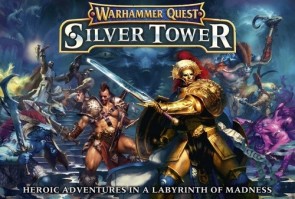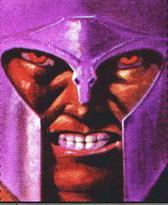Games Workshop fired a shot across the bow of every dungeon crawl ever.
Sometimes I fear that board gaming, as a hobby, has reached peak dungeon crawl. Don’t get me wrong, I’m not really complaining. There’s something primal about taking a muscle-bound hero down a corridor and hacking away at monsters for a couple hours. But it’s also getting obvious that there are a lot of ways to go about it these days. There’s the classic black humor of Dungeonquest, the accessible bread-and-butter D&D Adventure System, and longer campaign-based systems like Descent and its children. Any new entry into the genre has to justify its own existence to some extent, and even then there are only so many hours in the week to spend slicing goblins. It’s into this crowded market that Games Workshop decided to reboot their classic Warhammer Quest franchise. The first game in the series, Silver Tower, arrived almost a full year ago, and it has risen to be one of my favorite board games of the past year or so. It’s a dungeoncrawl that manages to lean into the gamier elements of the genre, giving something that works best in a board game form, rather than a game that tries hard to work in another medium.
Silver Tower is a cooperative game. The players are all heroes in GW’s new Age of Sigmar, having entered the Silver Tower, realm of the Tzeentch and his Gaunt Summoner. The players are presented with a series of trials in which they recover artifacts, along the way gaining skills and treasures that will help them in their endeavors. The backbone of the game is the action dice system. At the beginning of the their turns, players roll four dice that will be used to take different actions. Moving and exploring only require a die showing 1 or more pips, but stronger actions will require larger roles. There is also a common pool of dice the players can draw from, which are rolled at the beginning of the round. Monsters are spawned when certain rooms come up. When it’s a monster’s turn, they will roll a d6 and consult a table on their description that says how they will behave this round. It feels a little like the monster activations in the D&D board games, although this is much more unpredictable and wild.
As befitting a shrine to the Changer of Ways, the Silver Tower is a mercurial setting. You can play the same scenario over and over again, and it will feel drastically different every time. This is because the GW has created a system where the possibilities for any trial are highly variable. The rooms will come out in a different order, different events will be activated through die rolls, and monsters will follow different strategies. All of this is tied together with the Adventure Book, a book filled with paragraphs that give the players some great narrative beats and different challenges to overcome. I am frankly in love with the Adventure Book, because it has such a broad sampling of challenges. Some are speed-based, but some revolve around dexterity elements. There are puzzles or riddles, and lots of choices that could produce unforeseen consequences. Although the finales of the different scenarios will only surprise once, the journeys to those finales take so many unexpected turns that the game still manages to surprise.
Using so many random elements to create the system runs a big risk, thematically speaking. It makes no mechanical effort to hide the fact that you are playing a game, and while I don’t mind that so much it doesn’t serve the immersion of the experience. But it is here that Silver Tower manages to find its secret weapon. Because it is set among the devotees of Tzeentch, the Warhammer Chaos God of change and volatility, the protean nature of the setting becomes a strength rather than a liability. Instead of feeling like something thrown together and generated randomly, Silver Tower feels alive and dangerous in a way that few board games manage.
The dungeon design isn’t the only thing that reflects the chaos of Warhammer. There’s the way the campaign is set up, where the players can choose to take on the trials in any order they please. There’s not a lot of narrative coherence from game to game, but it works because it meshes with the idea that the players are trapped and awaiting the next test from their capricious captor. This could feel a bit like a video game, but it actually offers huge flexibility to the players, who can pick the game up when convenient and set it aside for a while if necessary. Neither are the same players required for every session, or even the same adventurers, although more experienced adventurers will have more skills and treasure as they go. Those skills are acquired through a clever experience system that rewards players with “renown” when they kill a monster. Enough renown gives the player a new skill, although there’s no guarantee they will be able to keep those skills at the end of the scenario.
All of these design decisions come together to make a delightful experience. I’ve never played a dungeoncrawl that conveys such a sense of place. The artwork and production does a lot of heavy lifting here, as one would expect from Games Workshop. The tiles all show some weird combination of strange creatures, arcane machinery, and frightening pits into nothingness. Everything looks perfect, although the quality of the tiles and cardstock feels a bit wanting, especially for a game that is $150 (!) at retail. But what the production lacks in paper products it makes up for in plastic. As with every Games Workshop product, Silver Tower is meant to showcase their impressive line of miniatures, and the ones here are staggering. The sculpts are all in dynamic poses, and they are highly detailed. These are a model-maker’s dream, though they might prove intimidating for neophytes to the world of miniatures. They come with handy instructions for assembly though, and one can find no end of suggestions online from Games Workshop as to how best you can spend lots more money on fancy Citadel paints. I don’t really mind that, to be honest. Games Workshop has shown in the last year and a half that they are really serious about making solid board games, and even if one never painted these they would look terrific. (I do plan on painting mine, however.)
Because of its emphasis on setting and experience, Silver Tower plays into what I want out of a game like this. But if your favorite thing about dungeoncrawls is tactical nuance, you might find Silver Tower to be something of a letdown. That’s not to say there isn’t anything to think about here, quite the opposite in fact. But it is a very dicey game, and if you aren’t interested in its variety of challenges you might find the whole thing a bit gimmicky. The first time I played I wondered if it might be the dungeoncrawl that made me feel okay about getting rid of similar games, but that hasn’t been the case. It’s more the kind of game that I keep around because no other game really does the same thing, even those that are theoretically in the same genre.
Knowing that true believers will always shell out, GW has already released a second game in the Warhammer Quest line, Shadows Over Hammerhal. I have not yet played that version, and I am not certain I will get around to it. Unlike Silver Tower, Hammerhal is a GM-focused game, where one player needs to run the experience for the others. That’s not really something I’m interested in playing, although plenty of people I trust have given it very high praise. But the good thing is that Silver Tower feels very self-contained as it is. Not many games are able to really express a specific setting so well. Most impressive of all it’s able to lean into its own “board game” qualities to create something really special. Do we need another dungeoncrawl? If the result is as good as this one, then the answer is very likely yes.
 Games
Games How to resolve AdBlock issue?
How to resolve AdBlock issue? 

























